for Container-Grown Landscape Trees
California Dept of Forestry and Fire Protection
These guidelines were developed to assist landscape professionals in specifying high-quality, container-grown, landscape trees. They were developed by arboricultural and horticultural professionals in California (Quality Tree Committee) comprised of municipal arborists, urban foresters, nurserymen, landscape architects and other landscape specialists. Depending on species, intended use, and availability of the trees, some elements of these guidelines may need to be modified.
I. PROPER IDENTIFICATION
All trees shall be true to name as ordered or shown on the planting plans and shall be labeled individually or in groups by species and cultivar (where appropriate).
II. COMPLIANCE
All trees shall comply with federal and state laws and regulations requiring inspection for plant disease, pests and weeds. Inspection certificates required by law shall accompany each shipment of plants. Clearance from the County Agricultural Commissioner, if required, shall be obtained before planting trees originating outside the county in which they are to be planted. Even though trees may conform to county, state, and federal laws, the buyer may impose additional requirements.
III. TREE CHARACTERISTICS AT THE TIME OF SALE OR DELIVERY
A. TREE HEALTH
As typical for the species/cultivar, trees shall be healthy and vigorous, as indicated by:
§ foliar crown density
§ length of shoot growth (throughout crown) § size, color and appearance of leaves
§ uniform distribution of roots in the container media § appearance of roots
§ absence of twig and/or branch dieback
§ relative freedom from insects and diseases
Note: some of these characteristics cannot be used to determine the health of deciduous trees during the dormant season.
B. CROWN
1. Form: Trees shall have a symmetrical form as typical for the species/cultivar and growth form.
Good quality nursery shade tree
a) Central Leader: Trees shall have a single, relatively straight central leader and tapered trunk, free of co-dominant stems and vigorous, upright branches that compete with the central leader. Preferably, the central leader should not have been headed. However, in cases where the original leader has been removed, an upright branch at least ½ (one-half) the diameter of the original leader just below the pruning point shall be present.
Note: This section applies to single trunk trees grown with normal straightness, as typically used for street or landscape planting. This specification does not apply to plants that have been specifically cultured in the nursery or selected for unusual or unique shape, such as contorted forms, topiary forms, espalier forms, multi-stem, or clump forms.
Evaluating trunk and branch structure
Trunk structure: 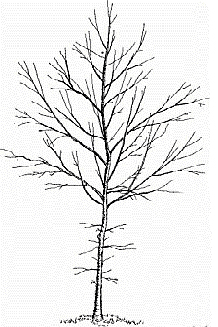 Shade trees that are large at maturity, and most evergreen trees, with the best quality have a dominant or central leader or trunk up to the top of the canopy. Shade trees of lesser quality have two or more leaders or trunks; they could split apart as they grow older. Small ornamental trees can have several trunks. (Note: Trees are drawn without leaves or small diameter branches to show their trunk and branch structure only. The end portions of large diameter branches are also cut off to save space in the illustration. These drawings apply to evergreens as well as deciduous trees).
Shade trees that are large at maturity, and most evergreen trees, with the best quality have a dominant or central leader or trunk up to the top of the canopy. Shade trees of lesser quality have two or more leaders or trunks; they could split apart as they grow older. Small ornamental trees can have several trunks. (Note: Trees are drawn without leaves or small diameter branches to show their trunk and branch structure only. The end portions of large diameter branches are also cut off to save space in the illustration. These drawings apply to evergreens as well as deciduous trees).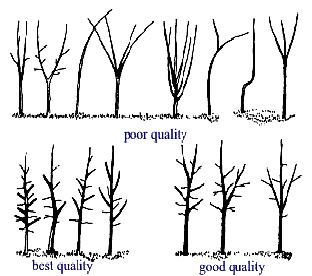
b) Potential Main Branches: Branches shall be distributed radially around and vertically along the trunk, forming a generally symmetrical crown typical for the species.
1. Potential main branches shall be evenly spaced and have appropriate space between them.
2. Branches shall be no larger than 2/3 (two thirds) the diameter of the trunk, measured 1" (one inch) above the branch.
3. The attachment of scaffold branches shall be free of included bark.
2) Branch structure: The better quality, large-maturing shade trees (lower extreme left) have all branches less than about two-thirds the trunk diameter. Poor quality shade trees (lower left center) have larger upright branches. Trees such as crape myrtle and other small-maturing trees can have several trunks. Trees with extensive defects in branches such as cracks and included bark (lower right) represent lesser quality than trees free of these potential problems. Included bark can be seen between the two arrows below. Branches with bark inclusions are weakly attached to the tree and can split easy. 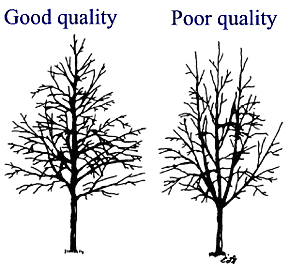
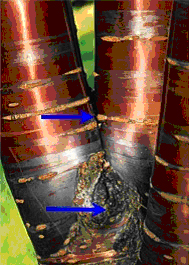
C) Temporary Branches: Unless otherwise specified, small "temporary" branches should be present along the lower trunk below the first potential permanent branch, particularly for trees less than 1-1/2" (one and one-half inches) in trunk diameter. Temporary branches should be distributed around and vertically along the lower trunk. They should be no greater than 3/8" (three-eighths inch) in diameter and no greater than ½ (one-half) the diameter of the trunk at the point of attachment. Heading of temporary branches is usually necessary to limit their growth.
C. TRUNK
1. Trunk diameter 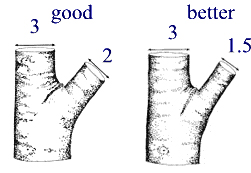 and taper shall be sufficient so that the tree will remain vertical without the support of a nursery stake.
and taper shall be sufficient so that the tree will remain vertical without the support of a nursery stake.
2. The trunk shall be free of wounds (except properly-made pruning cuts), sunburned areas, conks (fungal fruiting-bodies), wood cracks, bleeding areas, signs of boring insects, galls, cankers and/or lesions.
3. Trunk diameter at 6" (six inches) above the soil surface shall be within the diameter range shown for each container size below:
Container Soil Volume* Trunk Diameter (in) Soil level from Container Top (in)
# 5 0.6 0.5? to 0.75? 1.25? to 2?
# 15 3.3 0.75? to 1.5? 1.75? to 2.75?
24 inch box 10.5 1.5? to 2.5? 2.25? to 3
* Approximate soil volume in gallons
D. ROOTS
1. The trunk, root collar (root crown) and large roots shall be free of circling and/or kinked roots. Soil removal near the root collar may be necessary in order to verify that circling and/or kinked roots are not present.
2. The tree shall be well rooted in the container. 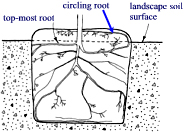 When the trunk is carefully lifted both the trunk and root system shall move as one.
When the trunk is carefully lifted both the trunk and root system shall move as one.
3. The upper-most roots or root collar shall be within 1" (one inch) above or below the soil surface. The soil level should be within 2? (two inches) of the top of the container (see table above) 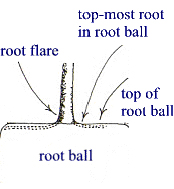 4. When the container is removed, the root ball shall remain intact.
4. When the container is removed, the root ball shall remain intact.
5. The root ball periphery should be free of large circling and bottom-matted roots. The acceptable diameter of circling peripheral roots depends on species and size of root ball. The maximum acceptable size should be indicated for the species (if necessary).
6. On grafted or budded trees, there shall be no suckers from the root stock.
E. MOISTURE STATUS
At time of inspection and delivery, the root ball shall be moist throughout, and the tree crown shall show no signs of moisture stress, as indicated by wilt. Roots shall show no signs of being subjected to excess soil moisture conditions, as indicated by root discoloration, distortion, death, or foul odor.
IV. INSPECTION
The buyer reserves the right to reject trees that do not meet specifications as set forth in these guidelines or as adopted by the buyer. If a particular defect or sub-standard element or characteristic can be easily corrected, appropriate remedies shall be required. If destructive inspection of root balls is to be done, the buyer and seller should have a prior agreement as to the time and place of inspection; minimum number and/or percentage of a species (cultivar) and as to who is financially responsibility for the inspected trees.
V. DELIVERY
The buyer should stipulate how many days notification are needed prior to delivery.
GLOSSARY:
Note: The word shall indicate a practice that is mandatory. The word should refers to a practice that is highly recommended.
Co-dominant branches- Those that are roughly equal in size to the trunk or branch on which they originate, or where two or more branches of relatively equal size fork or diverge from a common point. Co-dominate branches are usually vigorous and upright.
Crown? The portion of a tree above the trunk including the branches and foliage.
Cultivar? A named plant selection from which identical or nearly identical plants can be produced, usually by vegetative propagation or cloning.
Girdling root- A root that partially or entirely encircles the trunk and/or large buttress roots, which could restrict growth and downward movement of photosynthates.
Included bark? Bark that is entrapped in narrow-angled attachments of two or more stems, branches, or a stem and branch (es). Such attachments are weakly attached and subject to failure.
Kinked root- A taproot or a major root(s), which is sharply bent and can cause plant instability and reduction of movement of water, nutrients, and photosynthates.
Leader? The dominant stem or trunk that forms the apex of the tree.
Root collar? The flared lower portion of the base of a tree where the roots and stem merge. Also referred to as the "root crown" or ?root flare.?
Scaffold branches? In decurrent (round headed) trees , the branches that are among the largest on the tree and that form the main structure of the crown.
Stem- The axis (trunk of a central leader tree) of a plant on which branches are attached.
Temporary branch? A branch(s) that will remain on the tree for only a short period. Temporary branches will protect the trunk from sunburn damage and mechanical injury, and increase trunk caliper and taper thereby increasing trunk strength and flexibility. These branches are kept small and gradually removed as the trunk develops.
Trunk? The main stem of a tree between the ground and the lowest scaffold branch.
